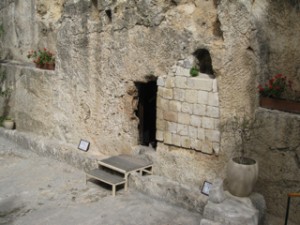
By Marney Blom
2000 years after Jesus’ resurrection was first reported, the ancient city of Jerusalem is still buzzing with the story – particularly during the Easter season.
For thousands of Christians visiting Israel last week, ground zero was the Garden Tomb, a large stone burial chamber located meters away from the “Golgotha” cliff, and a stone’s throw from the Damascus gate. Alternatively, orthodox pilgrims paid homage and said prayers at the church of the Holy Sepulcher, another proposed burial site of the crucified Christ.
Conveniently timed to coincide with the resurrection season this year, another site claimed to be the ultimate resting place of Jesus surfaced.
In the residential Jerusalem neighbourhood of Talpiot, ancient carvings of Jonah and the whale – believed to be the earliest iconic identification of the resurrection – were found on an ossuary (burial box) under an apartment block. In close proximity, a second ossuary engraved with an ancient Greek inscription alluding to the resurrection was discovered. Although the new find itself is astounding, the investigator’s interpretation of the engravings is troubling. Taking a swipe at the central tenet of the Christian faith, the new find “reinforced” the investigators’ earlier conjecture that the body of the risen Saviour had remained in the grave.
Follow Acts News Network for an upcoming report featuring the Resurrection.
Copyright © Acts News Network, Inc.
